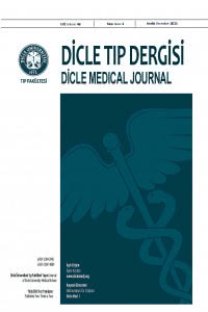Evaluation of Bax protein in breast cancer cells treated with tannic acid
Tannik asit uygulanan meme kanseri hücrelerinde Bax proteinin değerlendirilmesi
___
- 1. Parton M, Dowsett M, Smith I. Studies of apoptosis in breast cancer. Brit Med J 2001;322:1528-1532.
- 2. Henry-Mowatt J, Dive C, Martinou JC, James D. Role of mitochondrial membrane permeabilization in apoptosis and cancer. Oncogene 2004;23:2850-2860.
- 3. Debatin K-M. Apoptosis pathways in cancer and cancer therapy. Cancer Immunol Immun 2004;53:153-159.
- 4. Jeffrey S. Armstrong Mitochondria: a target for cancer therapy. Brit J Pharmacol 2006;147:239-248.
- 5. Martínez-Arribas F, Martín-Garabato E, Zapardiel I, et al. Bax expression in untreated breast cancer: an immunocytometric study of 255 cases. Anticancer Res 2008;28:5a2595-2598.
- 6. Sturm I, Kohne CH, Wolff G, Petrowsky H, et al. Analysis of the p53/BAX pathway in colorectal cancer: low BAX is a negative prognostic factor in patients with resected liver metastases. J Clin Oncol 1999;17:1364–1374.
- 7. Sturm I, Petrowsky H, Volz R, et al. Analysis of p53/BAX/p16(ink4a/CDKN2) in esophageal squamous cell carcinoma: high BAX and p16(ink4a/CDKN2) identifies patients with good prognosis. J Clin Oncol 2001;19:2272–2281.
- 8. Selvendiran K, Koga H, Ueno T, et al. Luteolin promotes degradation in signal transducer and activator of transcription 3 in human hepatoma cells: an implication for the antitumor potential of flavonoids. Cancer Res 2006;66:4826-4834.
- 9. Kuo PL, Lin CC. Green tea constituent (-)-epigallocatechin-3-gallate inhibits Hep G2 cell proliferation and induces apoptosis through p53-dependent and Fas-mediated pathways. J Biomed Sci 2003;10:219-27.
- 10. Lee HJ, Wang, CJ, Kuo HC, Chou FP, Jean LF, Tseng TH. Induction apoptosis of luteolin in human hepatoma HepG2 cells involving mitochondria translocation of Bax/Bak and activation of JNK. Toxicol Appl Pharmacol 2005;203:124-131.
- 11. Cowan MM. Plant products as antimicrobial agents. Clin Microbiol Rev 1999;12:564-582.
- 12. Taffetani S, Ueno Y, Meng F, et al. Tannic acid inhibits cholangiocyte proliferation after bile duct ligation via a cyclic adenosine 5’,3’- monophosphate-dependent pathway. Am J Pathol 2005;166:1671-1679.
- 13. Nam S, Smith DM, Dou QP. Tannic acid potently inhibits tumor cell proteasome activity, increases p27 and Bax expression, and induces G1 arrest and apoptosis. Cancer Epidem Biomar 2001;10:1083-1088.
- 14. Khan NS, Hadi SM. Structural features of tannic acid important for DNA degradation in presence of Cu (II). Mutagenesis 1998; 13: 271-274.
- 15. Sakagami H, Satoh K. Prooxidant action of two antioxidants: ascorbic acid and gallic acid; Anticancer Res 1997;17:221-224.
- 16. Liu KX, Yamamoto F, Sekine S, et al. Inhibitory effect of methylene blue-induced photooxidation on intimal thickening of vein graft. Ann Thorac Surg 1999;68:84-88.
- 17. Chena K-S, Hsiao Y-C, Kuo D-Y, et al. Tannic acid-induced apoptosis and -enhanced sensitivity to arsenic trioxide in human leukemia HL-60 cells. Leukemia Res 2009;33:297-307.
- 18. Li B, Dou QP. Bax degradation by the ubiquitin⁄proteasome-dependent pathway: involvement in tumor survival and progression. Proc Natl Acad Sci Usa 2000;97:3850-3855.
- 19. Bawadi HA, Bonsode RR, Trappey A, Truax RE, Losso JN. Inhibition of CaCo-2 colon, MCF-7 and Hs578T breast and Du145 prostatic cancer cell proliferation by water-soluble black bean condensed tannins. Cancer Lett 2005;218: 153-162.
- 20. Romero I, Paez A, Ferruelo A, Lujan M, Berenguer A. Polyphenols in red wine inhibit the proliferation and induce apoptosis of LNCaP cells. BJU Int 2002;89:950-954.
- ISSN: 1300-2945
- Yayın Aralığı: 4
- Başlangıç: 1963
- Yayıncı: Cahfer GÜLOĞLU
Severe Rotavirus gastroenteritis in a patient with infant leukemia
Ali BAY, Vuslat BOŞNAK, Enes COŞKUN, Ali Seçkin YALÇIN, Hatice UYGUN, Şamil HIZLI
Servikal lenfadenit nedeni olarak tularemi
Ahmet EYİBİLEN, Adnan EKİNCİ, İbrahim ALADAĞ
Diyabetik ayak enfeksiyonlu hastalarda Wagner sınıflaması ve kültür sonuçlarının değerlendirilmesi
Fatma BOZKURT, Recep TEKİN, Mustafa Kemal ÇELEN, Celal AYAZ
Kronik subdural hematoma bağlı gelişen Parkinsonizm olgusu
Adalet ARIKANOĞLU, Remziye HÜNKAR, Kadir ÇINAR
Diklofenak ve parasetamolun intihar amaçlı kullanımına bağlı subkonjonktival kanama gelişen iki olgu
Esra YILDIZHAN, Ali KUTLUCAN, Adem GÜNGÖR, Cağrı KILIÇ, Hayati KANDİŞ
Konjenital blefaroptozisli olgularda levator palpebra superior kasının histolojik değerlendirmesi
Sevda SÖKER, Sevin ÇAKMAK, Murat AKKUŞ, YUSUF NERGİZ
Kırşehir bölgesindeki dispeptik hastalarda Helicobacter pylori antijen prevalansı
Tülin DEMİR, Meral TURAN, Alicem TEKİN
Child maltreatment: Abuse and neglect
Bengü PALA, Murat ÜNALACAK, İLHAMİ ÜNLÜOĞLU
Sibel AKYOL, Yasin ÇINAR, Tuba ÇINAR, Muhammet Kazım EROL, Anıl KUBALOĞLU, Erol COŞKUN, Nihal AŞIK, Yusuf ÖZERTÜRK
İshalli çocuklarda Cryptosporidium spp. ve diğer barsak parazitlerinin yaygınlığı
